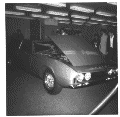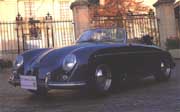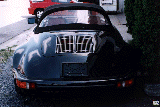 the IMP at Nurburgring(I.I.)
the IMP at Nurburgring(I.I.)
 the Apollo GT at the Turin autoshow(I.I.)
the Apollo GT at the Turin autoshow(I.I.)
Intermeccanica came into existance in 1959 when a chemical engineer by the
name of Frank Reisner founded Construzione Automobili Intermeccanica in
Turin, Italy. Born in Hungary in the winter of 1932, Frank Reisner fled Budapest
seventeen years later with his
parents to Montreal, Canada after a particularly miserable winter. He became
indirectly involved with cars by working in the paints industry. After
marrying in 1957, Frank and his wife Paula, both car fanatics, built and
raced a sports car for a while before visiting Europe and deciding to move
to Italy. Mr. Reisner designed racing chassis for Giannini Automobili SpA in
Rome before settling in Turin.
The first Intermeccanica products were, innocently enough, speed equipment kits and free-flow exhaust system for various automobiles. In 1960 things got more interesting when a Formula Junior racing car, one of the first rear-engined ones, with a highly-modified Peugeot motor was constructed. The same year a prototype of an aluminum two seater coupe called the IMP (short for Intermeccanica-Puch), with a top speed of 160 km/h, based on the small rear-engined Steyr-Daimler-Puch 500cc car was developed. It was approved by the Austrian company and 21 were produced in various forms. A racing version of it won the 500cc class at Nurburgring.
 the IMP at Nurburgring(I.I.)
the IMP at Nurburgring(I.I.)
 the Apollo GT at the Turin autoshow(I.I.)
the Apollo GT at the Turin autoshow(I.I.)
After this successful beginning, the Apollo GT, a sports-car based on Buick mechanicals (including a V8 powerplant), was developed for a U.S. company called International Motor Cars. The body was designed by the Italian Franco Scaglione from sketches made by Ron Plescia. The San Francisco firm produced 90 in coupe form and 11 in convertible form between 1961 and 1965, uphostered in leather and equipped with, among other things, Borrani wire wheels. The Apollo 2+2 protoype then followed, being judged 'best of show' at the New York Autoshow, a second copy being later built.
In 1965 the Veltro prototype, based on the British Ford 106E, was constructed and a Mustang Station Wagon was created for a U.S. advertising agency and later proposed to Ford in the U.S.A. Another U.S. project that year was a joint-venture with Jack Griffith of Long Island, New York, set-up for a planned big (for Intermeccanica standards) production of an all-steel automobile. Unfortunetaly, just as production started, Griffith's company folded and one of its customers, Steve Wilder, took over and production continued by Holman & Moody in North Carolina, where 33 of these Omegas were sold.
 (J.D.)
(J.D.)
 the Mustang station wagon (I.I.)
the Mustang station wagon (I.I.)
The big news for 1966 was the fact that an Intermeccanica distributor was found in the U.S. and the production of the Ford-V8-engined Italia (initially called Torino), based on Ford mechanicals, was started there and numbered 500 cars by 1970. Because of this, production levels of Intermeccanica automobiles surpassed a 100 per year. And once again a prototype, called Phoenix and based on the Corvair, was constructed for a U.S. company, Fitch in this case.
 the Italia(I.I.)
the Italia(I.I.)
 the Murena(J.D.)
the Murena(J.D.)
The following year, 11 copies of the Murena GT station wagon were produced for a U.S. importer. These 429bhp Ford-429-HiPerformance-engined luxury cars sported leather seats, deep pile carpets, and a cut glass drinking bar.
In '69 at the New York Automobile show there were 3 Intermeccanica-developed cars were displayed at various stands, demonstrating how far the firm had come since its humble beginnings. Sales of the previously mentioned Italia finally began in Europe in 1970, and really took off in Germany, where Erich Bitter was doing the distribution. Plus, a modified Italia prototype, called Italia IMX, was constructed and displayed at the Turin Auto show.
 the Italia IMX(I.I.)
the Italia IMX(I.I.)
 the Indra(I.I.)
the Indra(I.I.)
The succeeding year a one-off Corvette-based 2-door sedan called Centaur
was made for a U.S. customer and a
co-operation with Opel (GM Europe) was started, giving birth to the Indra.
The Chevrolet-351-engined Indra employed Opel mechanicals and generated a
phenomenal amount of interest at the Geneva Auto show. Thus, production got
under way in 1971 and by 1974 125 of them were produced in various forms. It
appeared that things were going very well when suddenly GM pulled the plug on
the mechanicals and engines, which of course meant the end of Indra sales.
On top of that confusion, Erich Bitter had produced the Bitter CD. It was based on the Opel Diplomat and looked remarkably like the Indra.
The bright note for the year 1972 was the assembly of Squires, Jaguar SS replicas,
for a U.S. company called Squire.
Click
here to see Paul Negyesi's article about it.
The year 1975 seemed that matters would became really favourable very soon. It was starting to be quite expensive for a company such as Intermeccanica to operate in Italy. Therefore, when word came that the Economic Development Council in the California city of San Bernardino would be willing to finance an automobile production project, Frank Reisner, wife Paula and their children (Henry, Edward, and Evelyn), seeing a great opportunity, moved to the desert city. Before this, however, two prototypes of the Indra were constructed, this time sporting Ford engines, and were shipped there along with all the firm's belongings including complete cars, jigs, dies, and other things needed for production. Unfortunately the promised Federal money was diverted and except for the sole Indra, everything else was impounded at the port. So the moving costs and paying off of debts in Italy left Frank with only $500 and one car, which was shortly sold off to raise some money.
Later that year and the next, Frank
developed what Intermeccanica would be most famous for, a replica of the
Porsche Speedster. The fact that so many Speedsters, costing quite a bit
at that, could be seen on the streets of California greatly influenced the
decision. The tooling and prototype were made in Los Angeles, after a long
time measuring the curves and dimension of a rented Speedster. It is significant
to note that ever since he first saw it at an auto show in '49, Frank has always
admired the beautiful body and the wonderful sounds of the Porsche 356 and
its close relatives.
In order to produce the Speedsters, Mr. Reisner formed a partnership with
Tony Baumgartner in Santa Ana, California. This company, Automobili
Intermeccanica, produced about 600 of these fibreglass-bodied and VW-based
beauties before Frank sold off his share to Tony and the whole project was
sold to Classic Motor Carriages in Florida. And so everything was back to
good times again.
Around 1979 and '80 a design and tooling was developed for the construction of a massive neo-classic sedan with a 129 inch wheelbase on the Checker (of taxi cab fame) chassis. During this time, however, the California economy experienced a downturn and the market for such a vehicle collapsed. A more succesful project for 1980 was the design for a soft-top conversion kit for the Ford Mustang being sold through Ford dealers.
A visit to Vancouver, B.C. was paid in 1981, foreshadowing a move there the following year. Before this took place Frank developed the glassfibre-bodied Roadster RS, a replica of the 1959 Porsche Convertible 'D' (D for Drautz), based again on a VW Beetle pan.
So, in 1982 Intermeccanica International Inc. is born in Vancouver and the Roadster RS goes into production. Quite a bit of these were made and they were mostly sold to Japanese and U.S. customers before some structural changes were made to the RS, including the replacement of the VW pan with a newly developed tubular chassis, arguably making the car an improvement over the Porsche itself.
 the Roadster 356 (or RS)(I.I.)
the Roadster 356 (or RS)(I.I.)
Later on the RS was further refined with the addition of fender flares, a modified front, a hardtop, a new steel tubular chassis and the use of the mechanicals of the 6-cylinder Porsche 911.
Henry Reisner, Frank's eldest son, has learned the trade from his Father and has been successfully running the business for some time now.
 the Roadster Turbo
the Roadster Turbo 
Currently Intermeccanica International offers a variety of high-quality hand-built replicas of the Porsche 356 and its derivatives, and a replica of the VW Kubelwagen.
 the Kubelwagen replica(I.I.)
the Kubelwagen replica(I.I.)
 (I.I.)
(I.I.)
 (I.I.)
(I.I.)